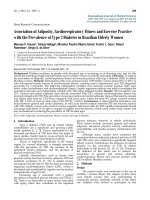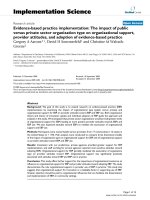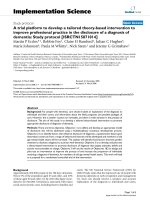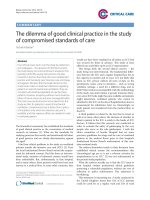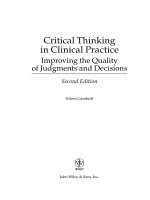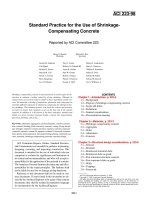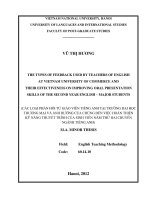Graduate School - Verbal And Quantitative Practice, Gre
Bạn đang xem bản rút gọn của tài liệu. Xem và tải ngay bản đầy đủ của tài liệu tại đây (158.51 KB, 12 trang )
Preparing for the
Verbal and Quantitative
Sections of the
GRE General Test
Sample Questions
with Explanations
Copyright © 2002 by Educational Testing Service. All rights reserved.
EDUCATIONAL TESTING SERVICE, ETS, the ETS logos, GRADUATE RECORD EXAMINATIONS, and GRE
are registered trademarks of Educational Testing Service.
®
Graduate Record Examinations
®
2
The sample questions that follow are organized by content category
and represent the types of questions included in the General Test.
The purpose of these questions is to provide some indication of the
range of topics covered in the test as well as to provide some addi-
tional questions for practice purposes. These questions do not
represent either the length of the actual test or the proportion
of actual test questions within each of the content categories.
VERBAL ABILITY
The verbal ability measure is designed to test the ability to reason
with words in solving problems. Reasoning effectively in a verbal
medium depends primarily upon the ability to discern, comprehend,
and analyze relationships among words or groups of words and
within larger units of discourse such as sentences and written
passages.
The verbal measure consists of four question types: analogies,
antonyms, sentence completions, and reading comprehension sets.
The examples of verbal questions in this section do not reflect pre-
cisely the difficulty range of the verbal measure.
ANALOGIES
Analogy questions test the ability to recognize the relationship that
exists between the words in a word pair and to recognize when two
word pairs display parallel relationships. To answer an analogy
question, you must formulate the relationship between the words in
the given word pair and then must identify the answer choice con-
taining words that are related to one another in most nearly the same
way. Some examples of relationships that might be found in anal-
ogy questions are relationships of kind, size, spatial contiguity,
or degree.
Some approaches that may be helpful in answering analogy
questions:
Ⅲ Before looking at the answer choices, try to establish a precise
relationship between the words in the given pair. It is usually
helpful to express that relationship in a phrase or sentence. Next,
look for the answer choice with the pair of words whose relation-
ship is closest to that of the given pair and can be expressed in a
similar fashion.
Ⅲ Occasionally, more than one of the answer choices may seem at
first to express a relationship similar to that of the given pair. Try
to state the relationship more precisely or identify some aspect of
the relationship between the given pair of words that is paralleled
in only one choice pair.
Ⅲ Remember that a single word can have several different mean-
ings. Check to be sure you have not overlooked a possible second
meaning for one of the words.
Ⅲ Never decide on the best answer without reading all the answer
choices.
Ⅲ Practice recognizing and formulating relationships between word
pairs. You can do this with the following sample questions.
Directions: In each of the following questions, a related pair of
words or phrases is followed by five lettered pairs of words or
phrases. Select the lettered pair that best expresses a relation-
ship similar to that expressed in the original pair.
1. COLOR : SPECTRUM : : (A) tone : scale
(B) sound : waves (C) verse : poem
(D) dimension : space (E) cell : organism
The relationship between color and spectrum is not merely that of
part to whole, in which case (E) or even (C) might be defended as
correct. A spectrum is made up of a progressive, graduated series of
colors, as a scale is of a progressive, graduated sequence of tones.
Thus, (A) is the correct answer choice. In this instance, the best
answer must be selected from a group of fairly close choices.
2. HEADLONG : FORETHOUGHT : :
(A) barefaced : shame (B) mealymouthed : talent
(C) heartbroken : emotion (D) levelheaded : resolve
(E) singlehanded : ambition
The difficulty of this question probably derives primarily from the
complexity of the relationship between headlong and forethought
rather than from any inherent difficulty in the words. Analysis of the
relationship between headlong and forethought reveals the follow-
ing: an action or behavior that is headlong is one that lacks fore-
thought. Only answer choice (A) displays the same relationship
between its two terms.
ANTONYMS
Although antonym questions test knowledge of vocabulary more
directly than do any of the other verbal question types, the purpose
of the antonym questions is to measure not merely the strength of
your vocabulary but also the ability to reason from a given concept
to its opposite. Antonyms may require only rather general knowl-
edge of a word, or they may require you to make fine distinctions
among answer choices. Antonyms are generally confined to
nouns, verbs, and adjectives; answer choices may be single
words or phrases.
Some approaches that may be helpful in answering antonym
questions:
Ⅲ Remember that you are looking for the word that is the most
nearly opposite to the given word; you are not looking for a
synonym. Since many words do not have a precise opposite,
you must look for the answer choice that expresses a concept
most nearly opposite to that of the given word.
Ⅲ In some cases more than one of the answer choices may appear at
first to be opposite to the given word. Questions that require you
to make fine distinctions among two or more answer choices are
best handled by defining more precisely or in greater detail the
meaning of the given word.
Ⅲ It is often useful, in weighing answer choices, to make up a
sentence using the given word or words. Substituting the
answer choices in the phrase or sentence and seeing which best
“fits,” in that it reverses the meaning or tone of the sentence or
phrase, may help you determine the best answer.
Ⅲ Remember that a particular word may have more than one
meaning.
Ⅲ Use your knowledge of root, prefix, and suffix meanings to
help you determine the meanings of words with which you
are not entirely familiar.
Sample Questions with Explanations
3
Directions: Each question below consists of a word printed in
capital letters followed by five lettered words or phrases.
Choose the lettered word or phrase that is most nearly opposite
in meaning to the word in capital letters. Since some of the
questions require you to distinguish fine shades of meaning,
be sure to consider all the choices before deciding which one
is best.
3. DIFFUSE : (A) contend (B) concentrate
(C) imply (D) pretend (E) rebel
The best answer is (B). Diffuse means to permit or cause to spread
out; only (B) presents an idea that is in any way opposite to diffuse.
4. MULTIFARIOUS :
(A) deprived of freedom (B) deprived of comfort
(C) lacking space (D) lacking stability
(E) lacking diversity
Multifarious means having or occurring in great variety, so the best
answer is (E). Even if you are not entirely familiar with the meaning
of multifarious, it is possible to use the clue provided by “multi-” to
help find the right answer to this question
SENTENCE COMPLETIONS
The purpose of the sentence completion questions is to measure the
ability to use the various kinds of cues provided by syntax and
grammar to recognize the overall meaning of a sentence. In decid-
ing which of five words or sets of words can best be substituted for
blank spaces in a sentence, you must analyze the relationships
among the component parts of the incomplete sentence. You must
consider each answer choice and decide which completes the sen-
tence in such a way that the sentence has a logically satisfying
meaning and can be read as a stylistically integrated whole.
Sentence completion questions provide a context within which to
analyze the function of words as they relate to and combine with
one another to form a meaningful unit of discourse.
Some approaches that may be helpful in answering sentence
completion questions:
Ⅲ Read the entire incomplete sentence carefully before you con-
sider the answer choices. Be sure you understand the ideas
expressed and examine the sentence for possible indications of
tone (irony, humor, and the like).
Ⅲ Before reading the answer choices, you may find it helpful to fill
in the blanks with a word or words of your own that complete the
meaning of the sentence. Then examine the answer choices to see
if any of them parallels your own completion of the sentence.
Ⅲ Pay attention to grammatical clues in the sentence. For example,
words like although and nevertheless indicate that some qualifi-
cation or opposition is taking place in the sentence, whereas
moreover implies an intensification or support of some idea in
the sentence.
Ⅲ If a sentence has two blanks, be sure that both parts of your
answer choice fit logically and stylistically into the sentence.
Ⅲ When you have chosen an answer, read the complete sentence
through to check that it has acquired a logically and stylistically
satisfying meaning.
Directions: Each sentence below has one or two blanks, each
blank indicating that something has been omitted. Beneath the
sentence are five lettered words or sets of words. Choose the
word or set of words for each blank that best fits the meaning
of the sentence as a whole.
5. Early ------- of hearing loss is ------- by the fact that the other
senses are able to compensate for moderate amounts of loss,
so that people frequently do not know that their hearing is
imperfect.
(A) discovery . . indicated
(B) development . . prevented
(C) detection . . complicated
(D) treatment . . facilitated
(E) incidence . . corrected
The statement that the other senses compensate for partial loss of
hearing indicates that the hearing loss is not prevented or corrected;
therefore, choices (B) and (E) can be eliminated. Furthermore, the
ability to compensate for hearing loss certainly does not facilitate
the early treatment (D) or the early discovery (A) of hearing loss. It
is reasonable, however, that early detection of hearing loss is com-
plicated by the ability to compensate for it. The best answer is (C).
6. The ------- science of seismology has grown just enough so
that the first overly bold theories have been -------.
(A) magnetic . . accepted
(B) fledgling . . refuted
(C) tentative . . analyzed
(D) predictive . . protected
(E) exploratory . . recalled
At first reading, there may appear to be more than one answer
choice that “makes sense” when substituted in the blanks of the
sentence. (A), (C), and (D) can be dismissed fairly readily when it is
seen that accepted, tentative, and protected are not compatible with
overly bold in the sentence. Of the two remaining choices, (B) is
superior on stylistic grounds: theories are not recalled (E), and
fledgling (B) reflects the idea of growth present in the sentence.
READING COMPREHENSION
The purpose of the reading comprehension questions is to measure
the ability to read with understanding, insight, and discrimination.
This type of question explores your ability to analyze a written
passage from several perspectives, including the ability to recognize
both explicitly stated elements in the passage and assumptions
underlying statements or arguments in the passage as well as the
implications of those statements or arguments. Because the written
passage upon which reading comprehension questions are based
presents a sustained discussion of a particular topic, there is ample
context for analyzing a variety of relationships; for example, the
function of a word in relation to a larger segment of the passage, the
relationships among the various ideas in the passage, or the relation
of the author to his or her topic or to the audience.
There are six types of reading comprehension questions. These
types focus on (1) the main idea or primary purpose of the passage;
(2) information explicitly stated in the passage; (3) information or
ideas implied or suggested by the author; (4) possible applications
of the author’s ideas to other situations, including the identification
4
of situations or processes analogous to those described in the pas-
sage; (5) the author’s logic, reasoning, or persuasive techniques; and
(6) the tone of the passage or the author’s attitude as it is revealed in
the language used.
Some reading comprehension questions ask a question like the
following: “Which of the following hypothetical situations most
closely resembles the situation described in the passage?” Such
questions are followed by a series of answer choices that are not
explicitly connected to the content of the reading passage but
instead present situations or scenarios from other realms, one of
which parallels something in the passage in a salient way. You are
asked to identify the one answer choice that is most clearly analo-
gous to the situation presented in the passage.
In each edition of the General Test, there are three or more
reading comprehension passages, each providing the basis for
answering two or more questions. The passages are drawn from
different subject matter areas, including the humanities, the social
sciences, the biological sciences, and the physical sciences.
Some approaches that may be helpful in answering reading com-
prehension questions:
Ⅲ Since reading passages are drawn from many different disciplines
and sources, you should not expect to be familiar with the mate-
rial in all the passages. However, you should not be discouraged
by encountering material with which you are not familiar; ques-
tions are to be answered on the basis of the information provided
in the passage, and you are not expected to rely on outside knowl-
edge, which you may or may not have, of a particular topic.
Ⅲ Whatever strategy you choose, you should analyze the passage
carefully before answering the questions. As with any kind of
close and thoughtful reading, you should be sensitive to clues
that will help you understand less explicit aspects of the passage.
Try to separate main ideas from supporting ideas or evidence; try
also to separate the author’s own ideas or attitudes from informa-
tion he or she is simply presenting. It is important to note transi-
tions from one idea to the next and to examine the relationships
among the different ideas or parts of the passage. For example,
are they contrasting? Are they complementary? You should con-
sider both the points the author makes and the conclusions he or
she draws and also how and why those points are made or con-
clusions drawn.
Ⅲ Read each question carefully and be certain that you understand
exactly what is being asked.
Ⅲ Always read all the answer choices before selecting the best
answer.
Ⅲ The best answer is the one that most accurately and most com-
pletely answers the question being posed. Be careful not to pick
an answer choice simply because it is a true statement; be careful
also not to be misled by answer choices that are only partially
true or only partially satisfy the problem posed in the question.
Ⅲ Answer the questions on the basis of the information provided
in the passage and do not rely on outside knowledge. Your own
views or opinions may sometimes conflict with the views
expressed or the information provided in the passage; be sure
that you work within the context provided by the passage. You
should not expect to agree with everything you encounter in
reading passages.
Directions: The passage is followed by questions based on its
content. After reading the passage, choose the best answer to
each question. Answer all questions following the passage on
the basis of what is stated or implied in the passage.
Picture-taking is a technique both for annexing the
objective world and for expressing the singular self.
Photographs depict objective realities that already exist,
though only the camera can disclose them. And they
depict an individual photographer’s temperament, dis-
covering itself through the camera’s cropping of reality.
That is, photography has two antithetical ideals: in the
first, photography is about the world, and the photogra-
pher is a mere observer who counts for little; but in the
second, photography is the instrument of intrepid,
questing subjectivity and the photographer is all.
These conflicting ideals arise from a fundamental
uneasiness on the part of both photographers and view-
ers of photographs toward the aggressive component in
“taking” a picture. Accordingly, the ideal of a photogra-
pher as observer is attractive because it implicitly denies
that picture-taking is an aggressive act. The issue, of
course, is not so clear-cut. What photographers do can-
not be characterized as simply predatory or as simply,
and essentially, benevolent. As a consequence, one ideal of
picture-taking or the other is always being rediscovered
and championed.
An important result of the coexistence of these two
ideals is a recurrent ambivalence toward photography’s
means. Whatever the claims that photography might
make to be a form of personal expression on a par with
painting, its originality is inextricably linked to the pow-
ers of a machine. The steady growth of these powers has
made possible the extraordinary informativeness and
imaginative formal beauty of many photographs, like
Harold Edgerton’s high-speed photographs of a bullet
hitting its target or of the swirls and eddies of a tennis
stroke. But as cameras become more sophisticated, more
automated, some photographers are tempted to disarm
themselves or to suggest that they are not really armed,
preferring to submit themselves to the limits imposed by
premodern camera technology because a cruder, less
high-powered machine is thought to give more interest-
ing or emotive results, to leave more room for creative
accident. For example, it has been virtually a point of
honor for many photographers, including Walker Evans
and Cartier-Bresson, to refuse to use modern equipment.
These photographers have come to doubt the value of the
camera as an instrument of “fast seeing.” Cartier-Bresson,
in fact, claims that the modern camera may see too fast.
This ambivalence toward photographic means deter-
mines trends in taste. The cult of the future (of faster and
faster seeing) alternates over time with the wish to return
to a purer past — when images had a handmade quality.
This nostalgia for some pristine state of the photographic
enterprise is currently widespread and underlies the
present-day enthusiasm for daguerreotypes and the work
of forgotten nineteenth-century provincial photographers.
Photographers and viewers of photographs, it seems, need
periodically to resist their own knowingness.
(5)
(10)
(15)
(20)
(25)
(30)
(35)
(40)
(45)
(50)
(55)
5
7. According to the passage, the two antithetical ideals of
photography differ primarily in the
(A) value that each places on the beauty of the finished
product
(B) emphasis that each places on the emotional impact
of the finished product
(C) degree of technical knowledge that each requires
of the photographer
(D) extent of the power that each requires of the
photographer’s equipment
(E) way in which each defines the role of the
photographer
The best answer to this question is (E). Photography’s two ideals
are presented in lines 7-11. The main emphasis in the description
of these two ideals is on the relationship of the photographer to the
enterprise of photography, with the photographer described in the
one as a passive observer and in the other as an active questioner.
(E) identifies this key feature in the description of the two ideals
— the way in which each ideal conceives or defines the role of the
photographer in photography. (A) through (D) present aspects of
photography that are mentioned in the passage, but none of these
choices represents a primary difference between the two ideals
of photography.
8. According to the passage, interest among photographers in
each of photography’s two ideals can best be described as
(A) rapidly changing
(B) cyclically recurring
(C) steadily growing
(D) unimportant to the viewers of photographs
(E) unrelated to changes in technology
This question requires one to look for comments in the passage
about the nature of photographers’ interest in the two ideals of pho-
tography. While the whole passage is, in a sense, about the response
of photographers to these ideals, there are elements in the passage
that comment specifically on this issue. Lines 20-22 tell us that the
two ideals alternate in terms of their perceived relevance and value,
that each ideal has periods of popularity and of neglect. These lines
support (B). Lines 23-25 tell us that the two ideals affect attitudes
toward “photography’s means,” that is, the technology of the cam-
era; (E), therefore, cannot be the best answer. In lines 46-49, atti-
tudes toward photographic means (which result from the two ideals)
are said to alternate over time; these lines provide further support
for (B). (A) can be eliminated because, although the passage tells us
that the interest of photographers in each of the ideals fluctuates
over time, it nowhere indicates that this fluctuation or change is
rapid. Nor does the passage say anywhere that interest in these ide-
als is growing; the passage does state that the powers of the camera
are steadily growing (line 28), but this does not mean that interest in
the two ideals is growing. Thus (C) can be eliminated. (D) can be
eliminated because the passage nowhere states that reactions to the
ideals are either important or unimportant to viewers’ concerns.
Thus (B) is the best answer.
QUANTITATIVE ABILITY
The quantitative section of the General Test is designed to measure
basic mathematical skills, and understanding of elementary math-
ematical concepts, as well as the ability to reason quantitatively and
to solve problems in a quantitative setting.
In general, the mathematics required does not extend beyond that
usually covered in high school. It is expected that examinees are
familiar with conventional symbolism, such as x < y (x is less than y)
and x y (x is not equal to y), m n (line m is parallel to line n),
m
⊥
n (line m is perpendicular to line n), and the symbol for a right
angle in a figure:
A
B
C
(∠ABC is a right angle).
Also, standard mathematical conventions are used in the test
questions unless otherwise indicated. For example, numbers are
in base 10, the positive direction of a number line is to the
right, and distances are nonnegative. Whenever nonstandard
notation or conventions are used in a question, they are explic-
itly introduced in the question.
Many of the questions are posed as word problems in a real-
life setting, with quantitative information given in the text of a
question or in a table or graph of data. Other questions are
posed in a pure-math setting that may include a geometric fig-
ure, a graph, or a coordinate system. The following conventions
about numbers and figures are used in the quantitative section.
Numbers and Units of Measurement
All numbers used are real numbers.
Numbers are to be used as exact numbers, even though in
some contexts they are likely to have been rounded. For ex-
ample, if a question states that “30 percent of the company’s
profit was from health products,” then 30% is to be used as an
exact percent; it is not to be used as a rounded number obtained
from, say, 29% or 30.1%.
An integer that is given as the number of objects in a real-life
or pure-math setting is to be taken as the total number of these
objects. For example, if a question states that “a bag contains
50 marbles, and 23 of the marbles are red,” then 50 is to be
taken as the total number of marbles in the bag and 23 is to be
taken as the total number of red marbles in the bag, so that the
other 27 marbles are
not red.
Questions may involve units of measurement such as English
units or metric units. If an answer to a question requires con-
verting one unit of measurement to another, then the relation-
ship between the units is provided, unless the relationship is a
common one, such as minutes to hours, or centimeters to
meters.
Figures
Geometric figures that accompany questions provide infor-
mation useful in answering the questions. However, unless a
note states that a geometric figure is drawn to scale, you should
solve these problems not by estimating sizes by sight or by
measurement, but by reasoning about geometry.
Geometric figures consist of points, lines (or line segments),
curves (such as circles), angles, regions, etc., and labels that
identify these objects or their sizes. (Note that geometric fig-
ures may appear somewhat jagged on a computer screen.)
Geometric figures are assumed to lie in a plane unless other-
wise indicated.
Points are indicated by a dot, a label, or the intersection of
two or more lines or curves.
Points on a line or curve are assumed to be in the order
shown; points that are on opposite sides of a line or curve are
assumed to be oriented as shown.



